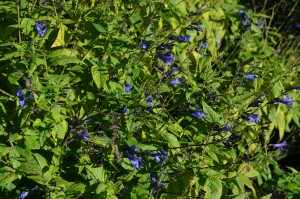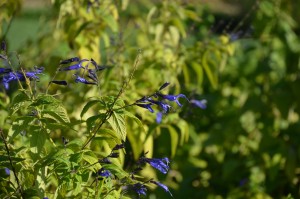Blue anise sage (Salvia guaranitica) is native to central South America (USDA hardiness zones 7-10). It primarily utilized as a garden annual in the U.S., but is rated a tender perennial in protected locations with winter mulch cover in zone 6. Plants exhibit a shrubby, somewhat open habit with upright branching, to 3-5 feet tall as a perennial and 2 ½ to 3 feet tall as an annual. Grow it in garden beds and in large containers.
For many years ‘Black and Blue’ has been the leading cultivar. Now introducing ‘Black and Bloom’ with thicker leaves, larger blooms and darker stems. It is heat, humidity, and drought tolerant. Through most of summer into fall, its electric blue, two-lipped, tubular, 2 inches long flowers contrast strikingly with the blackish stems. Dark green ovate leaves measure 2-5 inches in length and are paler green on the underside. The foliage emits a very mild anise odor when crushed.
Blue anise sage prefers a well-drained, rich loamy, mildly acidic pH soil, and in full to partial sun (6 hours minimum sunlight for good flowering). Cut back stems once in late spring for shorter, better branched plants. Start seeds indoors 6-8 weeks before last spring frost date or purchase plants at garden centers. Feed plants at planting time and again in mid-summer. Deadheading spent flowers will extend its bloom period.
Blue anise sage is troubled by very few serious insect or disease problems. Occasionally, sages are susceptible to downy and powdery mildew if planted in crowded spaces with poor sunlight and air circulation. Flowers attract numerous bees, butterflies, and hummingbirds. Deer usually stay away.



 Posted in
Posted in 
